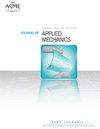Peeling of Finite-Length Plates From an Elastomeric Foundation: A 1-D Cylindrical Bending Solution
IF 2.8
4区 工程技术
Q2 MECHANICS
引用次数: 0
Abstract
Quasi-static peeling of a finite-length, flexible, horizontal, one-dimensional (1-D) plate (strip, thin film) from a horizontal, thin, elastomeric layer (foundation) is considered. The displaced end of the plate is subjected to an upward deflection or to a rotation. The top of the interlayer is perfectly bonded to the plate, and its lower surface is bonded to a rigid, flat substrate. A transversality (debonding) condition is derived for peeling, based on the common fracture mechanics approach. Whereas debonding from a Winkler foundation can be expressed in terms of the displacement (or equivalently the foundation stress ) at the bond termination, the sixth-order formulation involves a more complex debonding criterion. Transversality relationships are used to describe this limit state (here the onset of debonding) in terms of co-state variables, herein the deflection and slope at the peel front. In the analysis, bending is assumed to be paramount, linear Kirchhoff-Love (classical) plate theory is used to model the deformation, and therefore displacements are assumed to be small. The foundation is linearly elastic and incompressible. The effects of the work of adhesion, the length of the plate, and the initial nonbonded length of the plate are investigated. The results are compared to those for a Winkler foundation. By replacing the shear modulus of the interlayer by viscosity, and displacements by their time derivatives, the results are expected to apply to viscous liquid interlayers as well.弹性地基上有限长度板的剥离:一维圆柱弯曲解
考虑了有限长度的柔性水平一维(1-D)板(带、薄膜)从水平薄弹性体层(基础)上的准静态剥离。板的位移端受到向上偏转或旋转。中间层的顶部与板完美结合,其下表面与刚性平坦基板结合。基于常见的断裂力学方法,推导了剥离的横向(脱粘)条件。虽然Winkler地基的脱胶可以用粘结终止时的位移(或等效的地基应力)来表示,但六阶公式涉及更复杂的脱胶标准。横截面关系用于根据共态变量来描述这种极限状态(这里是脱粘的开始),这里是剥离前沿的偏转和斜率。在分析中,弯曲被认为是最重要的,线性Kirchhoff-Love(经典)板理论被用来模拟变形,因此位移被认为是小的。地基具有线性弹性且不可压缩。研究了粘附功、板的长度和板的初始非粘结长度的影响。将结果与Winkler基金会的结果进行了比较。通过用粘度代替夹层的剪切模量,用它们的时间导数代替位移,预计结果也适用于粘性液体夹层。
本文章由计算机程序翻译,如有差异,请以英文原文为准。
求助全文
约1分钟内获得全文
求助全文
来源期刊
CiteScore
4.80
自引率
3.80%
发文量
95
审稿时长
5.8 months
期刊介绍:
All areas of theoretical and applied mechanics including, but not limited to: Aerodynamics; Aeroelasticity; Biomechanics; Boundary layers; Composite materials; Computational mechanics; Constitutive modeling of materials; Dynamics; Elasticity; Experimental mechanics; Flow and fracture; Heat transport in fluid flows; Hydraulics; Impact; Internal flow; Mechanical properties of materials; Mechanics of shocks; Micromechanics; Nanomechanics; Plasticity; Stress analysis; Structures; Thermodynamics of materials and in flowing fluids; Thermo-mechanics; Turbulence; Vibration; Wave propagation

 求助内容:
求助内容: 应助结果提醒方式:
应助结果提醒方式:


